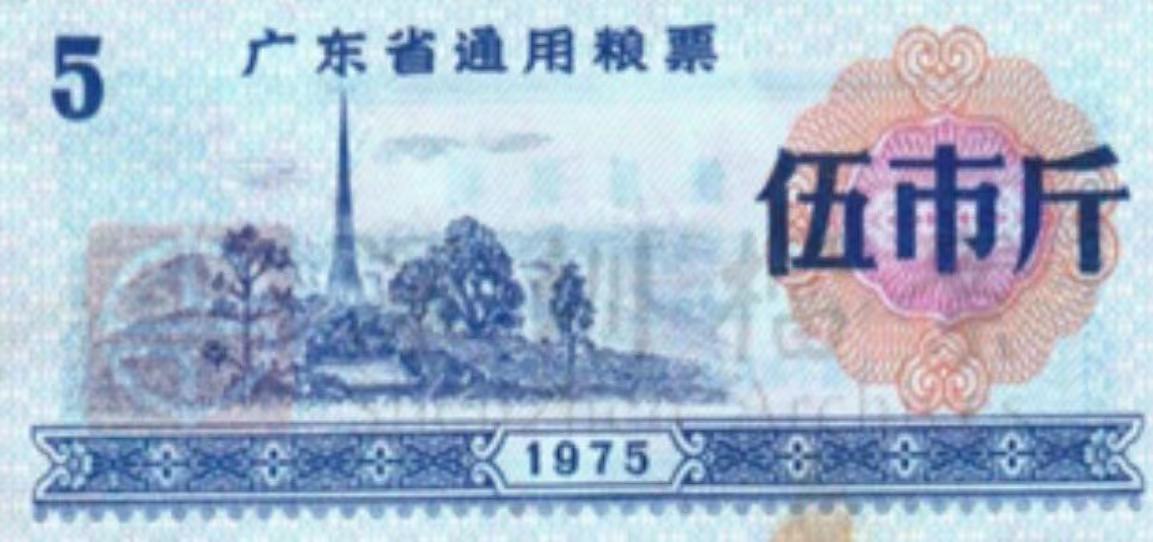

广东省旧粮票
A grain coupon of Guangdong Province.
这是一张1975年的旧粮票。对于上世纪六七十年代出生的人而言,粮油票证是抹不去的记忆。在那个年代,不管是采买商品还是外出就餐,都离不开票证。从什么时候起,粮票开始退出历史的舞台呢?故事可以从一家名为“泮溪酒家”的国营餐馆说起。
The picture above shows a grain coupon issued in 1975. For Chinese people born in the 1960s and 1970s, grain coupons issued by the government were once indispensable items in their life as they had to present grain coupons to buy food or have meals in restaurants. When did grain coupons begin to be phased out, and why? The story begins with a State-owned restaurant.
1982年4月,“泮溪酒家”正式开张迎客。刚开始生意红火异常,但不久后泮溪酒家总经理就愁眉苦脸地找到市政府反映问题。原来,有些没粮票的客人来了,点不了饭,饭店也没法通融,客人只好离开。
Panxi Restaurant, a renowned State-owned restaurant in Guangzhou, opened its Shenzhen branch in April 1982. Its booming business, however, tumbled only after a few months. The reason behind the restaurant’s falling business was that people were running out of grain coupons – many people came to Shenzhen from around the country and relevant policies back then stipulated that a city would only issue grain coupons to people whose hukou (official residency) was in the city. After people used up the grain coupons they brought with them from their hometowns, they were unable to buy food from the market or have meals in restaurants, and therefore would not be able to survive in the city. Shenzhen’s development would without a doubt suffer a blow if this issue could not be addressed.
起初深圳只有两三万人,但特区建立后,两年间三十多万人一下子涌入深圳,这些建设者大多没有把户口迁过来,第一个月粮票随身带,第二个月家里寄,到第三个月就接不上了。没有粮票,就无法买粮做饭,到饭店没有粮票也吃不到饭,他们在深圳就无法生存。因此,粮票问题成了当时特区发展遇到的一个大难题。
To prevent the lack of grain coupons from impacting people’s livelihood and the city’s development, the Shenzhen government made a bold decision for a trial with Panxi Restaurant. For ingredients exceeding the monthly rations the restaurant was allowed to buy with grain coupons, the restaurant could purchase them at higher prices from the market. Customers running out of grain coupons were also allowed to buy food or have meals in the restaurant, but they in turn would pay a higher price.
这一现象引起了深圳市政府的注意,经过详细了解后,深圳市政府决定以泮溪酒家不收粮票作为试验。得到了市里的许可,泮溪酒家开始从农贸市场购买高价米做饭。主食、点心卖给没有粮票的客人时,价格要比交粮票的客人高。比如当时的一碗米饭,有粮票的收5分钱,没有粮票的收5毛钱。新政策试行没几天,泮溪酒家的总经理就满心欢喜地向市政府汇报“没粮票也能吃饭, 大家都说好”!泮溪酒家的口子一开,其他饭店也纷纷效仿。不久以后,就连企业单位的职工食堂也可以“通融”了,不用粮票“卖饭”的地方越来越多。由此,深圳迈出了率先取消粮票、放开粮价的第一步。
The restaurant’s business boomed again thanks to the new policy, and many eateries, including restaurants and even the canteens of many public institutions and companies, began to follow suit. Shenzhen therefore became a pioneer in abolishing the use of grain coupons and allowing food prices to fluctuate according to market needs.
今日互动:对于上世纪六七十年代出生的人而言,粮油票证是抹不去的记忆。您的家中是否还保存有粮票?关于粮票,您有故事可以和我们分享吗?欢迎您踊跃留言,小i将在留言中选取三位幸运儿送出小礼物。
Today's topic: For those born in the 1960s and 1970s, grain coupons are an indelible memory. Do you still keep them at home? Do you have any stories about grain coupons to share with us? Feel free to leave your comments and three lucky people will receive gifts.

来源:深圳市档案馆、i深圳
Source: Shenzhen Archives, iShenzhen
编译:深圳政府在线、Shenzhen Daily、GDToday
Transedited by: Shenzhen Government Online, Shenzhen Daily, GDToday